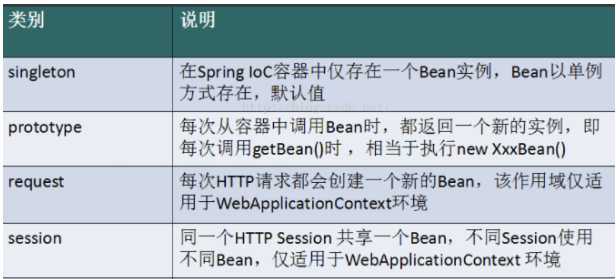标签:请求 entry 自动 项目 属性 合并 不同的 map 注入
<!-- 别名-->
<alias name="user" alias="user2"/><!--
id : bean的唯一标识符,相当于对象名
class : 全限定名 包名 + 类名
name : 也是别名,name可以同时起多个别名
-->
<bean id="userT" class="cn.imut.pojo.User" name="user3 u2,u3;u4">
<property name="name" value="1"/>
</bean>一般用于团队,它可以将多个配置文件,导入合并为一个
假设项目有多人开发,这三个人复制不同的类开发,不同的类需要注册在不同的bean中,我们可以利用import将所有人的beans.xml合并为一个总的 applicationContext.xml
使用时,直接用总的配置即可
前面已经说明
【环境搭建】
复杂类型
@Data
public class Address {
private String address;
}真实测试对象
@Data
@SuppressWarnings("all")
public class Student {
private String name;
private Address address;
private String[] books;
private List<String> hobbys;
private Map<String,String> card;
private Set<String> games;
private Properties info;
private String wife; //空指针
}beans.xml
<?xml version="1.0" encoding="UTF-8"?>
<beans xmlns="http://www.springframework.org/schema/beans"
xmlns:xsi="http://www.w3.org/2001/XMLSchema-instance"
xsi:schemaLocation="http://www.springframework.org/schema/beans
https://www.springframework.org/schema/beans/spring-beans.xsd">
<bean id="address" class="cn.imut.pojo.Address">
<property name="address" value="呼和浩特"/>
</bean>
<bean id="student" class="cn.imut.pojo.Student">
<!-- 第一种,普通值注入,value-->
<property name="name" value="张磊"/>
<!-- 第二种,bean注入,ref-->
<property name="address" ref="address"/>
<!-- 第三种,数组注入-->
<property name="books">
<array>
<value>红楼梦</value>
<value>水浒传</value>
<value>三国演义</value>
<value>西游记</value>
</array>
</property>
<!-- 第四种,List注入-->
<property name="hobbys">
<list>
<value>吃</value>
<value>喝</value>
<value>玩</value>
<value>乐</value>
</list>
</property>
<!-- 第五种,Map注入-->
<property name="card">
<map>
<entry key="身份证" value="123"/>
<entry key="QQ号" value="1234"/>
</map>
</property>
<!-- 第六种,Set注入-->
<property name="games">
<set>
<value>LOL</value>
<value>CF</value>
</set>
</property>
<!-- 第七种,null-->
<property name="wife">
<null/>
</property>
<!-- 第八种,properties-->
<property name="info">
<props>
<prop key="学号">123456</prop>
<prop key="姓名">张磊</prop>
<prop key="性别">男</prop>
</props>
</property>
</bean>
</beans>测试类
public class MyTest {
public static void main(String[] args) {
ApplicationContext context = new ClassPathXmlApplicationContext("beans.xml");
Student student = (Student) context.getBean("student");
System.out.println(student.toString());
}
}可以使用p或者c命名空间
<!-- p命名空间注入,可以直接注入属性-->
<bean id="user" class="cn.imut.pojo.User" p:name="张磊" p:age="18">
</bean>
<!-- c命名注入,通过构造器注入-->
<bean id="user2" class="cn.imut.pojo.User" c:age="18" c:name="张磊">
</bean>注意:p,c命名空间不能和直接使用,需要导入约束
xmlns:p="http://www.springframework.org/schema/p"
xmlns:c="http://www.springframework.org/schema/c"
单例模式(默认)
当一个bean的作用域为Singleton,那么Spring IoC容器中只会存在一个共享的bean实例,并且所有对bean的请求,只要id与该bean定义相匹配,则只会返回bean的同一实例。
Singleton是单例类型,就是在创建起容器时就同时自动创建了一个bean的对象,不管你是否使用,他都存在了,每次获取到的对象都是同一个对象。
<bean id="user2" class="cn.imut.pojo.User" c:age="18" c:name="张磊" scope="singleton">原型模式
当一个bean的作用域为Prototype,表示一个bean定义对应多个对象实例。Prototype作用域的bean会导致在每次对该bean请求(将其注入到另一个bean中,或者以程序的方式调用容器的getBean()方法)时都会创建一个新的bean实例。
Prototype是原型类型,它在我们创建容器的时候并没有实例化,而是当我们获取bean的时候才会去创建一个对象,而且我们每次获取到的对象都不是同一个对象。
<bean id="user2" class="cn.imut.pojo.User" c:age="18" c:name="张磊" scope="prototype">每次从容器get时,都会产生一个新的对象
其余的request、session、application只能在Web开发中使用到!
标签:请求 entry 自动 项目 属性 合并 不同的 map 注入
原文地址:https://www.cnblogs.com/yfyyy/p/12433396.html